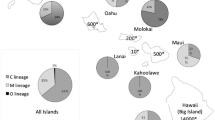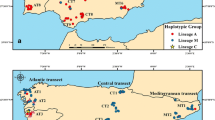Abstract
A sequence of the COI-COII intergenic region of the mitochondrial DNA of honeybees (Apis mellifera) was conducted to characterize the genetic basis of Ethiopian honeybee populations and elucidate the existing controversial concepts among morphologically identified local honeybee subspecies in Ethiopia. Samples of 204 honeybees were collected from 51 localities from eight regions (Oromia, Amhara, South Nation and Nationality people, Tigray, Afar, Somali, Beneshagul Gumaz and Gambella). Total genomic DNA was extracted from adult worker honeybee and amplified using E2 and H2 universal primers. Sequences of the COI-COII intergenic region generated from a total of 199 honeybees resulted in 15 haplotypes with a diversity value of 0.469. Within genetic variation (73.62%) was higher compared to among the population (26.38%). Lineages Y, A, and O were well separated, in which A and O are the first report for Ethiopia. The presence of four distinct groups of honey bee subspecies (A. m. jemenitica, A. m. litorea, A. m. syriaca, and A. m. iberiensis) could be now evident. A. m. jemenitica, categorized under lineage Y covers a large geographic area (83.43%) as compared to A. m. litorea (7.03%), A. m. syriaca (2.51%) and A. m. iberiensis (2.51%) that are categorized under linage A and O. Honeybees native to Saudi Arabia, carried by the reference subspecies A.m. jemenitica, categorized under lineage O were also accounted for 4.52%. A. m. jemenitica is the first report of honey bee subspecies in Ethiopia.





Similar content being viewed by others
Data Availability
Not applicable.
Code Availability
Not applicable.
References
Alattal Y, Alsharhi M, AlGhamdi A, Alfaify S, Migdadi H, Ansari M (2014) Characterization of the native honey bee subspecies in Saudi Arabia using the mtDNA COI-COII intergenic region and morphometric characteristics. Bull Insectol 67:31–38
Altschul S, Madden T, Schäffer A, Zhang J, Zhang Z, Miller W, Lipman D (1997) Gapped BLAST and PSI-BLAST: a new generation of protein database search programs. Nucleic Acids Res 25:3389–3402
Amssalu B, Nuru A, Radloff S, Hepburn H (2004) Multivariate morphometric analysis of honeybees (Apis mellifera) in the ethiopian region. Apidologie 34:72–81
Bandelt H, Forster P, Rohl A (1999) Median-joining networks for inferring intraspecific phylogenies. Mol Biol Evol 16:37–48
Chávez-Galarza J, Garnery L, Henriques D, Neves CJ, Loucif-Ayad W, Jonhston JS, Pinto MA (2017) Mitochondrial DNA variation of Apis mellifera iberiensis: further insights from a large-scale study using sequence data of the tRNAleu-cox2 intergenic region. Apidologie 48:533–544
Cridland J, Tsutsui N, Ramírezv S (2017) The complex demographic history and evolutionary origin of the western honey bee, Apis Mellifera. Genome Biol Evol 9:457–472
Excoffier L, Lischer H (2010) Arlequin suite ver 3.5: a new series of programs to perform population genetics analyses. Mol Ecol Resour 10:564–567
Felsenstein J (1985) Confidence limits on phylogenies: an Approach using the bootstrap. Evolution 39:783–791
Ferreri M, Gao J, Wang Z, Chen L, Su J, Han B (2011) Chinese holstein cattle shows a genetic contribution from native asian cattle breeds: a study of shared haplotypes and demographic history. Asian-Australasian J Anim Sci 24:1048–1052
Franck P, Garnery L, Celebrano G, Solignac M, Cornuet J (2000) Hybrid origins of honeybees from Italy (Apis mellifera ligustica) and Sicily (A. m. sicula). Mol Ecol 9:907–921
Franck P, Garnery L, Loiseauv A, Oldroyd B, Hepburn H, Solignac M, Cornuet J (2001) Genetic diversity of the honeybee in Africa: microsatellite and mitochondrial data. Heredity 86:420–430
Fu Y (1997) Statistical tests of neutrality of mutations against population growth, hitchhiking and background selection. Genetics 147:915–925
Garnery L, Cornuet J, Solignac M (1992) Evolutionary history of the honeybee Apis mellifera inferred from mitochondrial DNA analysis. Mol Ecol 1:145–154
Garnery L, Solignacv M, Celebrano G, Cornuetv JM (1993) A simple test using restricted PCR-amplified mitochondrial DNA to study the genetic structure of Apis mellifera L. Experientia 49:1016–1021
Govindaraju DR (1989) Variation in gene flow levels among predominantly self-pollinated plants. J Evol Biol 2:173–181
Hepburn H (1998) In: Radloff S (ed) Honeybees of Africa. Springer Verlag, Berlin, Germany
Kumar S, Stecher G, Li M, Knyaz C, Tamura K (2018) MEGA X: molecular evolutionary genetics analysis across computing platforms. Mol Biol Evol 35:1547–1549
Larkin MA, Blackshields G, Brown NP, Chenna R, Mcgettigan PA, McWilliam H, Valentin F, Wallace IM, Wilm A, Lopez R, Thompson JD, Gibson TJ, Higgins DG (2007) Clustal W and Clustal X version 2.0. Bioinformatics 23:2947–2948
Meixner M, Leta M, Koeniger N, Fuchs S (2011) The honey bees of Ethiopia represent a new subspecies of Apis mellifera - Apis mellifera simensis n. ssp. Apidologie 42:425–437
Meixner MD, Pinto MA, Bouga M, Kryger P, Ivanova E, Fuchs S (2013) Standard methods for characterising subspecies and ecotypes of Apis mellifera. J Apic Res 52:1–27
Munoz I, Stevanovic J, Stanimirovic Z, De la Rua P (2012) Genetic variation of Apis mellifera from Serbia inferred from mitochondrial analysis. J Apic Sci 56:59–69
Park D, Jung JW, Choi BS (2015) Uncovering the novel characteristics of asian honey bee, Apis cerana, by whole genome sequencing. BMC Genomics 16:1
Radloff S, Hepburn H (1997) Multivariate analysis of honeybees, Apis mellifera Linnaeus (Hymenoptera: Apidae), of the Horn of Africa. Afr Entomol 5:57–64
Rozas J, Ferrer-Mata A, Sanchez-DelBarrio J, Guirao-Rico S, Librado P, Ramos-Onsins S, Sanchez-Gracia A (2017) DnaSP 6: DNA sequence polymorphism analysis of large data sets. Mol Biol Evol 34:3299–3302
Ruttner F (1976) African races of honeybees. In: Proc. Int. Beekeeping Congr. 25, Apimondia 1–20
Ruttner F (1988) Biogeography and Taxonomy of Honeybee. Springer-Verlag
Ruttner F, Tassencourt L, Louveaux J (1978) Biometrical-Statistical analysis of the geographic variaability of Apis mellifera L. Apidologie 9:363–381
Saitou N, Nei M (1987) The neighbor-joining method: a new method for reconstructing phylogenetic trees. Mol Biol Evol 4:406–425
Sheppard WS, Meixner MD (2003) Apis mellifera pomonella, a new honey bee subspecies from the Tien Shan mountains of Central Asia. Apidologie 34:367–375
Sheppard WS, Arias MC, Grech A, Meixner MD (1997) Apis mellifera ruttneri, a new honeybee subspecies from Malta. Apidologie 28:287–293
Smith F (1961) Races of honeybees in East Africa. Bee world)
Solorzano C, Szalanski A, Kence M, McKern J, Austin J, Kence A (2009) Phylogeography and population genetics of honey bees (Apis mellifera) from Turkey based on COI-COII sequence data. Sociobiology 53:237–246
Tajima F (1989) Statistical method for testing the Neutral Mutation hypothesis by DNA polymorphism Fumio. Genetics 123:585–595
Tan K, Qu Y, Wang Z, Liu Z, Engel M (2016) Haplotype diversity and genetic similarity among populations of the Eastern honey bee from Himalaya-Southwest China and Nepal (Hymenoptera: Apidae). Apidologie 47:197–205
Wallberg A, Han F, Wellhagen G, Dahle B, Kawata M, Haddad N, Simoes Z, Allsopp M, Kandemir I, De la Rúa P, Pirk C, Webster M (2014) A worldwide survey of genome sequence variation provides insight into the evolutionary history of the honeybee Apis mellifera. Nat Genet 46:1081–1088
Whitfield CW, Behura SK, Berlocher SH, Clark AG, Johnston JS, Sheppard W, Smith DR, Suarez A, Weaver D, Tsutsui WD (2006) Thrice out of Africa: ancient and recent expansions of the honey bee, Apis mellifera. Science 314:642–645
Wright S (1978) Evolution and the genetics of populations. Chicago, University of Chicago Press, v. 4.Variability within and among natural populations
Zhao W, Tan K, Zhou D, Wang M, Cheng C, Yu Z, Miao Y, He S (2014) Phylogeographic analysis of Apis cerana populations on Hainan Island and southern mainland China, based on mitochondrial DNA sequences. Apidologie 45:21–33
Acknowledgements
This work was supported by Jimma University College of Agriculture and Vet. Medicine and Oromia Agricultural Research Institute (OARI).
Funding
This work was partially funded by Oromia Agricultural Research Institute and Jimma University College of Agriculture and Vet. Medicine.
Author information
Authors and Affiliations
Contributions
Tadele A. Hunde: Conceptualization, Methodology, Data curation, Formal analysis, Investigation, Writing-Original draft preparation, Visualization. Yosef D: Resource, Supervision, Methodology. Beira H. Meressa: Resource, Supervision, Methodology.
Corresponding author
Ethics declarations
Conflict of interest
The authors have no conflicting interest to declare.
Additional information
Publisher’s Note
Springer Nature remains neutral with regard to jurisdictional claims in published maps and institutional affiliations.
Rights and permissions
Springer Nature or its licensor (e.g. a society or other partner) holds exclusive rights to this article under a publishing agreement with the author(s) or other rightsholder(s); author self-archiving of the accepted manuscript version of this article is solely governed by the terms of such publishing agreement and applicable law.
About this article
Cite this article
Hunde, T.A., Deneke, Y. & Meressa, B.H. Molecular analyses of mitochondrial DNA reveal new haplotypes and lineages within Ethiopian honeybees (Apis mellifera). Int J Trop Insect Sci 43, 1327–1338 (2023). https://doi.org/10.1007/s42690-023-01046-y
Received:
Accepted:
Published:
Issue Date:
DOI: https://doi.org/10.1007/s42690-023-01046-y




